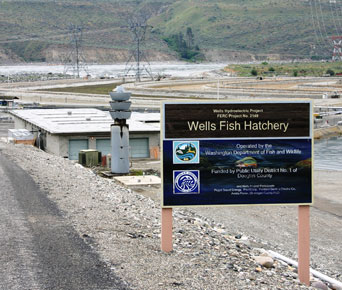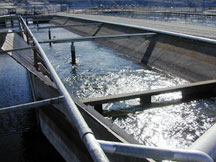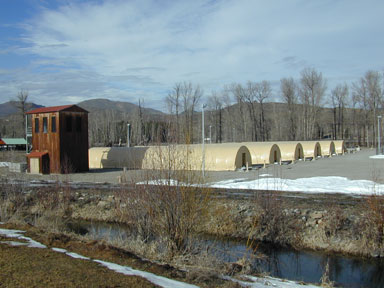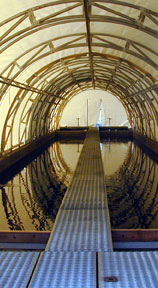Hatcheries & Acclimation Ponds
Douglas PUD provides funding for the operation and maintenance of
two hatchery facilities and three acclimation ponds. The Wells Fish
Hatchery facility is located immediately adjacent to Wells Dam. The
Methow Fish Hatchery is located approximately 51 miles up the Methow
River near the town of Winthrop, Washington. All three acclimation
ponds are part of the Methow Hatchery Complex and are used to
acclimate spring Chinook prior to release each April. Of the three
acclimation ponds, one is located on station at the Methow Fish
Hatchery, the second is located at river mile 11 on the Twisp River,
and the third is located at river mile 7 on the Chewuch River. All of
these hatchery facilities are funded by Douglas PUD and operated by
the Washington Department of Fish and Wildlife. They produce
approximately 3 million juvenile salmon and steelhead annually which
are released into the Methow, Okanogan and Columbia rivers.
 Wells
Hatchery Wells
Hatchery
Original construction of the Wells Hatchery was completed in 1967. The
hatchery produces summer Chinook, summer steelhead and rainbow trout. It was
originally developed to compensate for the loss of fish production resulting
from the inundation of the Columbia River above the dam. The Wells Hatchery
consists of a 6,100 foot long spawning channel with portions of the channel
modified to hold adults and juveniles, numerous above ground and in ground
raceways, four large earthen rearing ponds a centralized incubation, early
rearing, cold storage and administration building, vehicle storage building,
steelhead spawning building and a separate set of residences for hatchery
personnel.
 The
Wells Hatchery’s four earthen rearing ponds vary in size and purpose. Pond 1
is used for rearing yearling summer Chinook and is connected to the main
hatchery outfall channel via a gate and outlet structure. When acclimated
and ready for release, the juvenile summer Chinook are allowed access to the
main hatchery outfall channel and are volitionally released into the
Columbia River below Wells Dam. Pond 2 is the largest pond and has
historically been used to raise yearling summer steelhead. Ponds 3 and 4 are
used each year for the rearing of yearling summer steelhead. All of the
earthen steelhead rearing ponds have volitional collection and
transportation facilities located downstream of their outlet structures. All
of the summer steelhead raised at the Wells Hatchery are either truck
planted or acclimated in the Methow and Okanogan rivers. No juvenile
steelhead are released through the hatchery outfall channel. The
Wells Hatchery’s four earthen rearing ponds vary in size and purpose. Pond 1
is used for rearing yearling summer Chinook and is connected to the main
hatchery outfall channel via a gate and outlet structure. When acclimated
and ready for release, the juvenile summer Chinook are allowed access to the
main hatchery outfall channel and are volitionally released into the
Columbia River below Wells Dam. Pond 2 is the largest pond and has
historically been used to raise yearling summer steelhead. Ponds 3 and 4 are
used each year for the rearing of yearling summer steelhead. All of the
earthen steelhead rearing ponds have volitional collection and
transportation facilities located downstream of their outlet structures. All
of the summer steelhead raised at the Wells Hatchery are either truck
planted or acclimated in the Methow and Okanogan rivers. No juvenile
steelhead are released through the hatchery outfall channel.
 Methow Hatchery Methow Hatchery
Construction of the Methow Hatchery was completed in 1992 and is the
result of a Long-term Fish Settlement Agreement to mitigate for passage
losses at the Wells Project. In 2004, the Wells HCP was approved by FERC and
has replaced the Long-term Fish Settlement Agreement. As a result, the terms
of the HCP now guide activities at the Methow and Wells hatcheries. 
The Methow Hatchery produces yearling spring Chinook and is dedicated to
enhancing spring Chinook salmon in the Methow, Twisp and Chewuch river
basins. The Methow Hatchery consists of 12 covered production raceways,
three covered adult raceways, a centralized incubation, early rearing,
administrative and hatchery maintenance building, one on-site acclimation
pond, two satellite acclimation ponds, and a separate set of residences for
hatchery personnel.
All 12 of the production raceways and the on-site Methow acclimation pond
are equipped with an outlet channel to the Methow River for releasing
juvenile spring Chinook. The two satellite ponds are located at river mile
11 on the Twisp River, and the third is located at river mile 7 on the
Chewuch River. The Methow Hatchery program currently raises up to 550,000
yearling spring Chinook each year with equal numbers of fish released at
each of the three acclimation ponds.
[top of
page]
|





![]() Wells Project
Wells Project
![]() License Articles
License Articles
![]() Wells HCP
Wells HCP
![]() Annual Compliance Reports
Annual Compliance Reports



